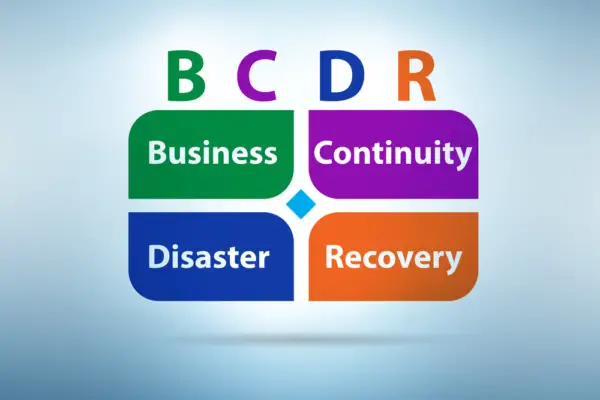To develop a business continuity plan effectively: assess risks, prioritize critical functions, form a dedicated team, develop safeguards and recovery strategies, and conduct regular training.
Determine potential threats, impact on key operations, and implement protective measures. Assign responsibilities, secure necessary resources, and establish post-disruption procedures.
Prioritize essential functions, enhance resilience, and optimize resource allocation. Safeguard with data encryption, cloud backups, and alternate work locations.

Test plans, refine procedures, and train the team consistently for operational readiness. This framework guarantees operational resilience and minimizes disruptions effectively.
Risk Assessment and Analysis
Risk assessment is an important step in creating a business continuity plan. By identifying potential threats and analyzing various risks, organizations can develop effective safeguards and strategies to mitigate disruptions.
This proactive approach helps guarantee quick functionality during crises and protects critical business functions.
Identify Potential Threats
Conducting a thorough analysis of potential threats to business operations is an essential initial step in the development of a robust business continuity plan.
By identifying risks through risk assessment, organizations can understand the potential disruptions that could impact critical business processes.
This enables the development of effective strategies to mitigate risks and prioritize resources for continuity planning. Below is a table illustrating the importance of identifying potential threats in the context of business continuity planning:
| Importance of Identifying Potential Threats |
|---|
| Helps prioritize resources for continuity planning |
| Enables the development of strategies to mitigate risks |
| Enhances preparedness for potential disruptions |
Identifying potential threats is fundamental to building a resilient business continuity plan.
Analyze Various Risks
Initiating a thorough assessment of potential risks is vital in developing a resilient business continuity plan. Organizations must conduct a thorough risk assessment to identify various threats, including natural disasters, cyber-attacks, and other disruptions that could impact operations.
By analyzing these risks, vulnerabilities can be pinpointed, and a robust risk management strategy can be developed. It is essential to involve a collective effort within the organization to address risks effectively and enhance resilience against potential disruptions.
This analysis stage lays the foundation for the creation of safeguards and recovery strategies in the business continuity plan.
Through a systematic approach to risk assessment and analysis, organizations can better prepare for and mitigate the impact of unforeseen events, ensuring continuity of critical operations.
Develop Safeguards Strategies
An essential aspect in fortifying business resilience involves devising proactive measures to mitigate identified threats to operational continuity.
Risk assessment plays a pivotal role in identifying potential threats to business operations, such as natural disasters, cyber-attacks, or supply chain disruptions.
Analysis of these risks helps determine the impact of disruptions on critical business functions and the organization as a whole.
Developing safeguards strategies is vital in implementing measures to effectively reduce or eliminate identified risks. These safeguards aim to protect key assets, personnel, and operations from disruptions that could lead to financial losses or reputational damage.

Critical Function Prioritization
Critical function prioritization is an essential aspect of business continuity planning. It involves identifying and ranking key business processes essential for maintaining operations during disruptions.
By prioritizing critical functions, organizations can allocate resources effectively, minimize downtime, and enhance overall business resilience.
Understanding the importance of prioritization and key function identification is fundamental in developing effective recovery strategies. It ensures operational continuity in times of crisis.
Key Function Identification
Prioritizing essential functions within an organization is a fundamental step in ensuring business continuity during times of disruption. Key functions are critical processes that are essential for the organization’s operations.
By prioritizing these key functions, resources can be allocated effectively during emergencies. This prioritization is typically based on the impact these functions have on revenue, reputation, and regulatory compliance.
Identifying key functions also helps in determining recovery time objectives (RTOs) and recovery point objectives (RPOs).
This process allows organizations to focus on maintaining essential operations during crises, ensuring that the organization can continue functioning despite disruptions.
Key function identification is an important aspect of business continuity planning, enabling organizations to prioritize their efforts and resources effectively.
Importance of Prioritization
Effective business continuity planning hinges on the strategic identification and prioritization of critical functions essential for organizational survival.
Prioritizing these functions is essential for allocating resources efficiently, reducing recovery time, and minimizing financial losses.
The importance of prioritization in a business continuity plan can be summarized as follows:
- Minimize Impact: By prioritizing critical business functions, organizations can minimize the impact of disruptions on essential operations.
- Enhance Resilience: Prioritization enhances the overall resilience of the organization by ensuring that key processes are quickly restored.
- Optimize Resources Allocation: Focusing on critical functions allows for the efficient allocation of resources, ensuring that the most essential aspects of the business are addressed first in disaster recovery plans.
Continuity Team Formation
When establishing a continuity team for your business continuity plan, it is essential to assign specific roles and responsibilities to team members.
The team leader plays a pivotal role in overseeing the development, implementation, and maintenance of the plan.
Additionally, having representatives from various departments ensures thorough coverage and effective coordination during crises.
Team Roles
Establishing clear team roles is a fundamental step in the formation of a business continuity plan’s continuity team. When assigning roles and responsibilities within the team, it is essential to guarantee effective management of disruptions. Key aspects to take into account include:
- Designating a Leader: Appointing a leader to oversee the implementation and execution of the continuity plan ensures clear direction and decision-making during emergencies.
- Defining Clear Tasks: Each team member should have well-defined roles and tasks, ensuring a smooth operation of the continuity plan.
- Leveraging Diverse Expertise: The team should consist of individuals with diverse skills and expertise relevant to different facets of the plan, facilitating thorough coverage and efficient problem-solving capabilities.
Training Needs
To adequately prepare the business continuity team for their roles and responsibilities, identifying key personnel with the requisite skills and expertise is paramount.
Training plays a vital role in ensuring that team members understand their roles in maintaining business operations during disruptions.
Regular drills and exercises should be conducted to practice response and recovery procedures with the continuity team, enhancing their preparedness for various scenarios.
Professional development opportunities should be encouraged to keep team members updated on best practices and industry trends.
Safeguards and Recovery Strategies
When developing a business continuity plan, organizations need to focus on implementing risk mitigation strategies and recovery plan implementation.
These strategies aim to prevent and minimize the impact of potential risks, such as natural disasters or cyber-attacks, on critical business functions.
Risk Mitigation Strategies
Effective risk mitigation strategies are essential components of a robust business continuity plan. They focus on implementing safeguards to reduce the impact of potential threats on business operations.
These strategies involve:
- Implementing data encryption and firewalls to enhance cybersecurity and prevent security breaches.
- Utilizing cloud backup solutions and redundant systems to guarantee data integrity and availability.
- Establishing alternate work locations for critical business functions to maintain operations during crises.
Recovery Plan Implementation
In the domain of business continuity planning, the successful implementation of a recovery plan hinges on meticulous safeguards and strategic recovery strategies.
Safeguards are protective measures that reduce risks, guaranteeing business functions can continue in the face of disruptions. Recovery strategies aim to restore critical business functions efficiently post-disruption.
Effective implementation involves designating responsibilities, allocating resources, and establishing procedures for a swift response.
These safeguards and strategies minimize the impact of disruptions on operations, finances, and reputation. Tailored recovery strategies align with specific Recovery Time Objectives (RTOs) and Recovery Point Objectives (RPOs) for different business functions.

This all-encompassing approach ensures readiness and resilience in the face of adversity.
| Key Aspect | Description |
|---|---|
| Safeguards | Protective measures to reduce risks and guarantee continuity |
| Recovery Strategies | Focus on restoring critical functions efficiently post-disruption |
| Implementation | Assigning responsibilities, resources, and procedures for a swift response |
Training and Testing Maintenance
Regular testing and training of a business continuity plan (BCP) are crucial components in maintaining organizational readiness during unexpected disruptions.
By conducting tabletop exercises, walk-throughs, and simulations, weaknesses in the plan can be identified and addressed promptly.
Involving both continuity team members and new employees in these drills helps guarantee that the BCP remains effective and up-to-date.
Regular BCP Testing
Performing regular testing of a business continuity plan (BCP) is important to confirm its functionality and preparedness for real-world disruptions.
Testing methods such as tabletop exercises, walk-throughs, and simulations are essential to assess the effectiveness of response strategies.
Here are three key reasons why regular BCP testing is crucial:
- Identifying Gaps: Testing helps pinpoint weaknesses in the plan, allowing for necessary adjustments to enhance overall resilience.
- Refining Procedures: Through testing, procedures can be improved and optimized to ensure a more efficient response during emergencies.
- Training Employees: Testing not only familiarizes employees with their roles but also highlights areas for improvement and provides valuable hands-on experience, especially for new employees. Involvement of senior management is important to ensure alignment with organizational objectives.
Training Continuity Team
To guarantee operational resilience and successful implementation of the business continuity plan, consistent training sessions are conducted for the continuity team.
Training ensures readiness and effectiveness in responding to potential disruptions. By testing the team’s capabilities through various scenarios, strengths and weaknesses in the plan can be identified and addressed. Maintenance of the team’s skills is crucial for adaptability during crises.
Regular drills and exercises improve the team’s ability to handle emergencies efficiently. Ensuring that each team member is well-versed in their roles and responsibilities facilitates swift and coordinated responses to business disruptions.
| Training | Readiness | Effectiveness |
|---|---|---|
| Consistent | Preparedness | Efficient |
| Testing | Maintenance | Swift |
| Scenarios | Adaptability | Coordinated |
Frequently Asked Questions
What Are the 5 Steps of a Business Continuity Plan?
The 5 steps of a business continuity plan involve risk assessment, business impact analysis, strategy development, plan development, and plan testing.
These steps are essential for identifying threats, minimizing disruptions, and ensuring operational continuity in times of crisis.
What Are the 4 P’s of Business Continuity?
The 4 P’s of Business Continuity are ‘Predict, Prevent, Prepare, and Perform.’ These principles guide organizations in anticipating, mitigating, planning for, and executing during disruptions.
‘Predict’ identifies threats, ‘Prevent’ reduces impact, ‘Prepare’ guarantees readiness, and ‘Perform’ executes plans effectively.
What Are the 4 Elements of Business Continuity Plan?
The four essential elements of a business continuity plan are risk assessment, business impact analysis, recovery strategies, and plan testing.
These components help organizations prepare for and recover from disruptions, ensuring operational resilience.
What Is a Business Continuity Plan Example?
A business continuity plan example is a documented strategy outlining procedures to maintain critical business functions during disruptions like natural disasters or cyber incidents.
It includes recovery protocols, communication strategies, and resource allocations for effective continuity.

Conclusion
In summary, a well-developed business continuity plan is vital for organizations to effectively navigate potential disruptions and ensure operational resilience.
By conducting thorough risk assessments, prioritizing critical functions, establishing a continuity team, implementing safeguards and recovery strategies, and regularly testing and maintaining the plan, businesses can enhance their ability to withstand challenges and maintain continuity in the face of adversity.
Prioritizing preparedness and proactive measures is essential for safeguarding business operations and assets.

Chris Ekai is a Risk Management expert with over 10 years of experience in the field. He has a Master’s(MSc) degree in Risk Management from University of Portsmouth and is a CPA and Finance professional. He currently works as a Content Manager at Risk Publishing, writing about Enterprise Risk Management, Business Continuity Management and Project Management.

